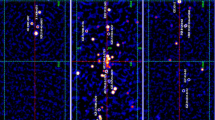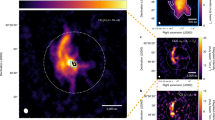Abstract
A thickening at the outer edge of the accretion disk is usually invoked to explain the dips in the light curves of cataclysmic variables with stationary disks at phases ∼0.7. The noncollisional interaction between the stream and the disk in the stationary solution raises the question of why matter appears at a considerable height above the accretion disk in such systems. Our three-dimensional numerical modeling demonstrates that a thickening of the halo above the disk can appear even in the absence of a direct collision between the stream and the disk. In the gas-dynamical flow pattern described with the “hot-line” model, a considerable fraction of the matter is accelerated in the vertical direction during the flow’s interaction with the circumdisk halo. The vertical motion of the gas due to the presence of the z component of the velocity leads to a gradual thickening of the circumdisk halo. The computations reveal the strongest thickening of the halo above the outer edge of the disk at phases ∼0.7, in agreement with observations for stationary-disk cataclysmic variables. This supports the hot-line model suggested earlier as a description of the pattern of the matter flows in semidetached binaries and presents new possibilities for interpreting the light curves of such systems.
Similar content being viewed by others
References
N. E. White and S. S. Holt, Astrophys. J. 257, 318 (1982).
K. O. Mason, in Two Topics in X-ray Astronomy, Vol. 1: X-ray Binaries (1989), ESA SP-296, p. 113.
M. Livio, N. Soker, and R. Dgani, Astrophys. J. 305, 267 (1986).
R. Dgani, M. Livio, and N. Soker, Astrophys. J. 336, 350 (1989).
M. Hirose, Y. Osaki, and S. Mineshige, Publ. Astron. Soc. Jpn. 43, 809 (1991).
S. H. Lubow and F. H. Shu, Astrophys. J. Lett. 198, 383 (1975).
S. H. Lubow and F. H. Shu, Astrophys. J. Lett. 207, L53 (1976).
S. H. Lubow, Astrophys. J. 340, 1064 (1989).
J. Frank, A. R. King, and J.-P. Lasota, Astron. Astrophys. 178, 137 (1987).
P. J. Armitage and M. Livio, Astrophys. J. 470, 1024 (1996).
K. O. Mason, F. A. Cordova, M. G. Watson, and A. R. King, Mon. Not. R. Astron. Soc. 232, 779 (1988).
K. S. Long, C. W. Mauche, J. C. Raymond, et al., Astrophys. J. 469, 841 (1996).
T. Naylor, G. T. Bath, P. A. Charles, et al., Mon. Not. R. Astron. Soc. 231, 237 (1988).
I. Billington, T. R. Marsh, K. Horne, et al., Mon. Not. R. Astron. Soc. 279, 1274 (1996).
E. T. Harlaftis, B. J. M. Hassall, T. Naylor, et al., Mon. Not. R. Astron. Soc. 257, 607 (1992).
K. O. Mason, J. E. Drew, and C. Knigge, Mon. Not. R. Astron. Soc. 290, L23 (1997).
C. S. Froning, K. S. Long, and C. Knigge, Astrophys. J. 584, 433 (2003).
D. V. Bisikalo, A. A. Boyarchuk, O. A. Kuznetsov, and V. M. Chechetkin, Astron. Zh. 74, 880 (1997) [Astron. Rep. 41, 786 (1997)].
D. V. Bisikalo, A. A. Boyarchuk, O. A. Kuznetsov, et al., Astron. Zh. 75, 40 (1998) [Astron. Rep. 42, 33 (1998)].
D. V. Bisikalo, A. A. Boyarchuk, V. M. Chechetkin, et al., Mon. Not. R. Astron. Soc. 300, 39 (1998).
A. A. Boyarchuk, D. V. Bisikalo, O. A. Kuznetsov, and V. M. Chechetkin, Mass Transfer in Close Binary Stars (Taylor and Francis, London, 2002).
D. V. Bisikalo, A. A. Boyarchuk, P. V. Kaigorodov, and O. A. Kuznetsov, Astron. Zh. 80, 879 (2003) [Astron. Rep. 47, 809 (2003)].
M. Makita, K. Miyawaki, and T. Matsuda, Mon. Not. R. Astron. Soc. 316, 906 (2000).
K. Sawada and T. Matsuda, Mon. Not. R. Astron. Soc. 255, 17P (1992).
P. L. Roe, Annu. Rev. Fluid Mech. 18, 337 (1986).
S. R. Chakravarthy and S. Osher, in Proceedings of the 23rd Aerospace Sci. Meeting (1985), AIAA-85-0363, p. 363.
O. A. Kuznetsov, D. V. Bisikalo, A. A. Boyarchuk, et al., Astron. Zh. 78, 997 (2001) [Astron. Rep. 45, 872 (2001)].
P. J. Groot, R. G. M. Rutten, and J. van Paradijs, Astron. Astrophys. 417, 283 (2004).
K. R. Bell and D. N. C. Lin, Astrophys. J. 427, 987 (1994).
Author information
Authors and Affiliations
Additional information
__________
Translated from Astronomicheski\(\overset{\lower0.5em\hbox{$\smash{\scriptscriptstyle\smile}$}}{l}\) Zhurnal, Vol. 82, No. 9, 2005, pp. 788–796.
Original Russian Text Copyright © 2005 by Bisikalo, Kaigorodov, Boyarchuk, Kuznetsov.
Rights and permissions
About this article
Cite this article
Bisikalo, D.V., Kaigorodov, P.V., Boyarchuk, A.A. et al. The possible nature of dips in the light curves of semidetached binaries with stationary disks. Astron. Rep. 49, 701–708 (2005). https://doi.org/10.1134/1.2045320
Received:
Accepted:
Issue Date:
DOI: https://doi.org/10.1134/1.2045320




